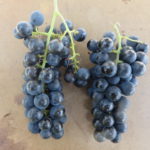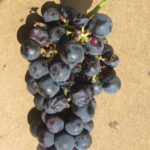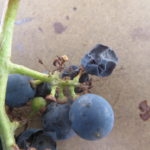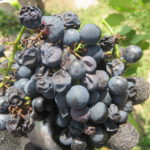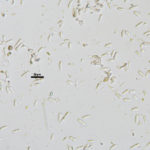There are a number of common grape pathogens that can cause fruit rots each year in the region. Black rot and Phomopsis cane and leaf spot are by far the most common fruit pathogens. We also see Botrytis gray mold on some cultivars in cooler regions and years. Another common rot is Sour rot, but it is actually caused by yeasts and bacteria, not filamentous fungi and is spread by fruit flies. It occurs most often when heavy rains near harvest cause berry splitting. I wrote about it in a recent issue.
In the past few years we’ve had a troubling rot on a new cultivar to the region, Marquette. This early ripening red has excellent wine quality and is one of the new “super cold hardy” cultivars from Minnesota. That makes it a great choice for northern Indiana vineyards. However, Marquette is not without disease problems. While only moderately susceptible to black rot, it is highly susceptible to Phomopsis cane and leaf spot. Extra measures taken to manage Phomopsis have not been successful at stopping all fruit rots on Marquette. So we investigated a bit further to discover that, in fact, a relatively unknown disease to our region causes a late-season fruit rot. Ripe rot is caused by Colletotrichum gloeosporioides and is common in the warm southern Atlantic wine growing regions, but not cooler regions of the Midwest. It may be that the disease is spreading more westward, or more likely, that Marquette is just particularly susceptible. Marquette ripens about 2 weeks earlier than most cultivars so it’s possible that higher temperatures during ripening are partially to blame.
One concern with ripe rot is that it can infect fruit during the ripening period. The other fruit rots we commonly deal with infect much earlier in the season, so growers quit applying fungicides after mid-summer as risk for infection is greatly diminished. The lack of late-season fungicide applications may be why we are seeing ripe rot show up on susceptible cultivars. We will have to change our recommendations to reflect this new threat. Captan, Ziram and strobilurin fungicides have good activity against ripe rot.
The primary symptom of ripe rot is rotting of ripe fruit. Symptoms are not common on leaves, shoots, or cluster stems (unlike Phomopsis that also causes a rot of ripe fruit). Affected berries develop circular, reddish brown spots on their skins and the spots subsequently enlarge to include entire berries. A key characteristic is that infected berries become covered with salmon-colored spore masses of conidia as they decay. Eventually diseased berries shrivel and resemble the terminal stages of several other rot diseases (black rot, Phomopsis). Presence of the characteristic salmon-colored conidia from acervuli is diagnostic for ripe rot.
- Healthy clusters of Marquette
- Early stages of ripe rot on Marquette
- Individual berry showing development of acervuli on surface
- Advanced stage of ripe rot with many shriveled berries with acervuli visible
- Acervulus of Colletotrichum gloeosporioides
- Spores of Colletotrichum gloeosporioides
